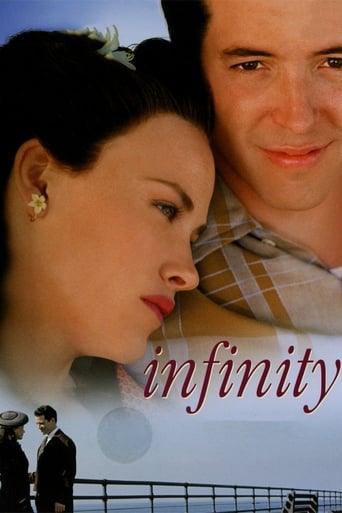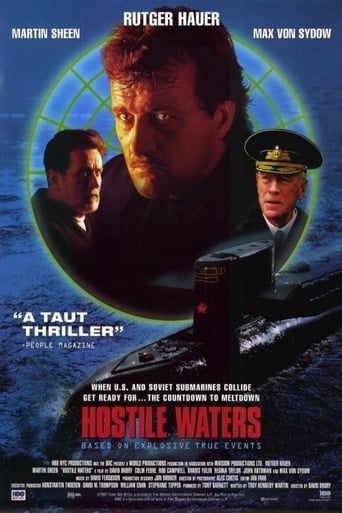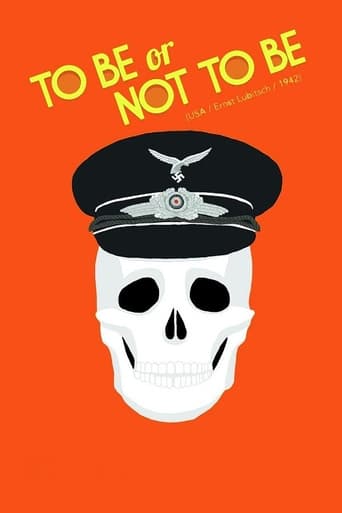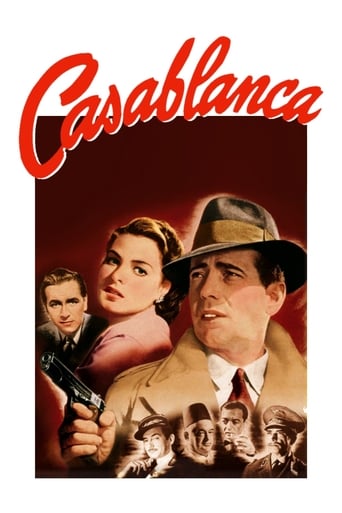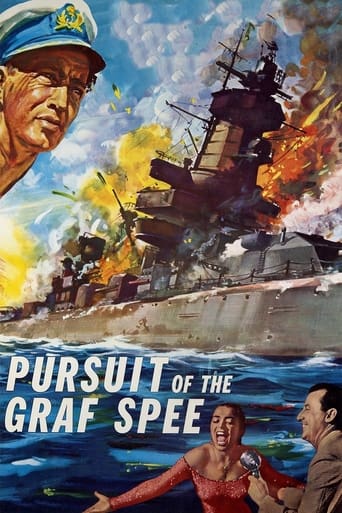

The Battle of the River Plate (1957)
In the early years of the World War II, the Royal Navy is fighting a desperate battle to keep the Atlantic convoy routes open to supply the British Isles, facing the great danger posed by the many German warships, such as the Admiral Graf Spee, which are scouring the ocean for cargo ships to sink.
Watch Trailer
Cast


Similar titles
Reviews
Cinematographically it is a poor, conventional film. Photography is at times excellent but that is not enough to overcome the defects of a mediocre script. The actors repeat their parts without much conviction (except Hawkins and Finch) and the Latin character of Christopher Lee (the future Dracula) deserves to be remembered in the history of cinema as one of the most exhilarating cartoons that have been seen in movies. For all the technical errors that the film contains and for the glamorous presentation of the cruelty of war, this work is disgusting. Not only is the view of war, the supposed chivalry of enemies, questionable, but also the lack of historical truth. The Graf Spee arrived at the coasts of Mar del Plata (south of the city of Buenos Aires) and there many sailors descended freely. This is top secret perhaps because of some unknown agreement between British, Argentines and Nazis. That is understandable in 1939, when the events occurred ... but not in 1956 when the film was made. In addition, to some extent, the no hidden admiration towards the Nazi chivalry shown in several scenes recalls Howard Hugues' "Hell's Angels" ... and Mr. Hugues had a great deal of sympathy for Nazi Germany. I do not know if it's a problem of inferiority complex on the part of Great Britain, but I remember that James Mason proudly incarnated Rommel in another film. It seems that not only several components of the British royal nobility admired the Nazis. In short: forgettable.
A straightforward WW2 naval battle flick, designed to show the courage and mettle of British officers in their battle against overwhelming Nazi firepower. THE BATTLE OF THE RIVER PLATE tells the true story of the German warship the Graf Spee, which proved invincible when up against Allied vessels until a bit of trickery and sheer determination saw it finally meet its match in the form of not one, not two, but three British ships off the coast of Uruguay.The film has the distinction of being filmed by Powell and Pressburger, two of the most famous directors in history, and thus it looks fantastic: colourful, full-blooded, with expert attention to detail and battle scenes that really look like the real thing. It's in the cast that this really excels, though; the production team have assembled one of the greatest all-star casts ever, and thus the film is dominated by strong performances from the likes of John Gregson, Anthony Quayle, Peter Finch, Michael Goodliffe, Bernard Lee, and many more besides. There are even smaller parts for future greats like John Le Mesurier, Christopher Lee, and Patrick Macnee.
The film divides into two parts, the first at sea, the second in the harbour of Montevideo, Uruguay, where the Graf Spee sought shelter after being damaged in battle with two British and one New Zealand warships.The first half suffer badly from what today we call low production values. This is not Tora! Tora! Tora! Apart from a few stock moments of a ship or two at sea, almost everything is done in studio, with very small sets--the bridge, a gun room--and the effect is of complete artificiality. The battle scenes consist of shots of the muzzles of ship's guns firing and, primarily, men in their little studio sets being lit up by orange flashes (the gun flashes, don't you know). When the Graf Spee fires salvos on the British ships, it is indicated by ridiculous splashes of water behind the men standing in their little sets, splashes that look very much like someone throwing a bucket of water into the air. Laughable. It's very hard to take the story seriously. The battle itself is almost entirely depicted with the British men in their little sets, with one or two extremely quick shots of model ships exploding in flames. Add to the low production values lots of very stilted dialogue. British prisoners held on the Graf Spee mutter as a group, then one speaks up and says his line, then another does the same, then a third, then everyone mutters agreement, all as obviously written and rehearsed as a play performed by 10-year-olds.The second part is somewhat of a relief in that it includes lots of outdoor scenes in Montevideo (it might really have been shot there). Still, in the climactic moment when the Graf Spee leaves the harbour, we watch a radio newsreporter tell us what the ship is doing; we don't see it for ourselves.There is more to say about the disappointment of this film. You should be warned, for example, that the battle does not begin until 45 minutes into the film, and the first 45 minutes are not exactly riveting. You need to be prepared, too, for the standard portrayal of Allies facing up to difficulties, all so chipper and not really worried about what might happen to them. It's too bad that a better job wasn't done of this dramatic battle.
Filmed in colour, which was very unusual for a British war movie of that era, this was a basically decent take on WW2 naval conflict.It's nice to sea genuine warships of the period in their full spectacular and menacing beauty, instead of the usual tacky and implausible models. Just check-out the 'sea-battle' of 'In Harm's Way' to sea how badly it could have been done.Lots of fine British character actors pop up and do their stuff. Anthony Quayle, John Gregson, Patrick Macnee and there are many more. There are also plenty of nice little details that often get overlooked, such as the gun-muzzles that become smoke-blackened after use. The actual battle sequences tend to look a little hokey nowadays, with the splashes of nearby shell-falls resembling a bucket of pelted water. Still; the destruction and confusion arising from direct hits are believable enough.Some commentators smirk at the stiff upper-lipped-ness of the characters portrayed, but these attitudes are, in fact, very authentic. It was terribly bad form to lapse into any kind of emotional display in those times of repressed Englishness, never mind the histrionics often (wrongly) depicted of Americans. People had a far greater sense of national obligation in those days, and lamenting one's personal losses implied a lack of proportion; everyone was suffering one way and another. A recently-interviewed former nurse who served in a war-casualty hospital remarked how, despite the most appalling injuries she had ever seen, no man ever swore or cried out in pain. The only exclamation of distress she ever heard was a whispered 'oh-dear'. There's a scene in the much more gritty 'Cruel Sea' in which a crew member, whilst writing a letter to his wife, is informed of her death in the blitz. He responds simply by saying 'I think I'll just go on deck for a while'. Everyone learnt to have a much greater sense of self-discipline and forbearance. They kept a good face and grieved in private. Unlike the wimps of today. Just look at the antics of a modern premier-league footballer who gets tripped-up.Another criticism has been levied about its predominantly British take on events. But what would one expect in 1956? The bleeding-heart liberal apologists hadn't taken over the media by then. In fact, Finch's Langsdorff and the Graff Spee crew in general offer a pretty sympathetic presentation of those who fought at sea for the most despicable regime of modern time. Let's not forget that this powerful warship was employed in sinking defenceless merchant vessels. When it came up against determined though still inferior-gunned adversaries, Langsdorff's response was to cut and run. Bearing in mind that the Battle is depicted from a British perspective and that they knew almost nothing of the mindset of their enemies, I'd say it is sufficiently evenly balanced for the story and the drama.I also like the way we patrol with the fleet as the dawn breaks on a clear morning. We see the sky brightening and the sun slowly rise as the aboard-ship dramas unfold.If I have a grumble about the movie it concerns the post-Montevideo section. Far too much of the drama is given over to the rogue reporter. His relentless hyperbole jars with the steadfast British understatement that dominated the first half of the action. But I suppose as American money funded it and an American warship had been borrowed to play the Graff Spee, they must be allowed in somewhere.Still, there's much to like and admire in this golden oldie, from top-drawer actors, excellent script, beautiful photography, and genuine warships of the time, as well as a largely authentic slice of history. Not many movies can boast all of these things. Just check-out U571.Recommended.






